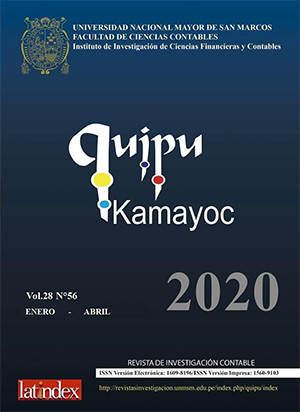The audit as continuous improvement in Peru's Public Health Agencies
DOI:
https://doi.org/10.15381/quipu.v28i56.17468Keywords:
Audit, MINSA, EsSalud, Public OrganismsAbstract
Objective: The research aimed to describe and explain how audit with criteria for continuous improvement could to improve the management of processes in state entities that provide care services, based on the recommendations that flow from the reports of the institutional control bodies, forming the National Control System, with the aim of achieving basic criteria of efficiency, efficiency, economy and legality in the health benefits made by the public sector , represented by the Ministry of Health -Minsa and EsSalud. Method: The approach of the study is quantitative, the type of descriptive, correlational and exploratory research, with non-experimental transactional design. Questionnaires were applied at Likert scale and dichotomous scale, the analysis of which was carried out comparing the technical audit procedures carried out in the hospitals of Minsa and Essalud , by analyzing cases, surveys and interviews in these health entities. Result: The results revealed that the provision of care services in someway depends on the implementation of recommendations from the audit services made, without which the services of assistance services remain poor. Conclusions: Sand concludes that the Internal Control and Audit Systems do not contribute to the improvement of hospital care systems, increasing the risk that these deficiencies adversely affect the user public.
Downloads
Downloads
Published
Issue
Section
License
Copyright (c) 2020 Alberto Benjamín Espinoza Valenzuela

This work is licensed under a Creative Commons Attribution-NonCommercial-ShareAlike 4.0 International License.
AUTHORS RETAIN THEIR RIGHTS:
a. Authors retain their trade mark rights and patent, and also on any process or procedure described in the article.
b. Authors retain their right to share, copy, distribute, perform and publicly communicate their article (eg, to place their article in an institutional repository or publish it in a book), with an acknowledgment of its initial publication in Quipukamayoc .
c. Authors retain theirs right to make a subsequent publication of their work, to use the article or any part thereof (eg a compilation of his papers, lecture notes, thesis, or a book), always indicating the source of publication (the originator of the work, journal, volume, number and date).






